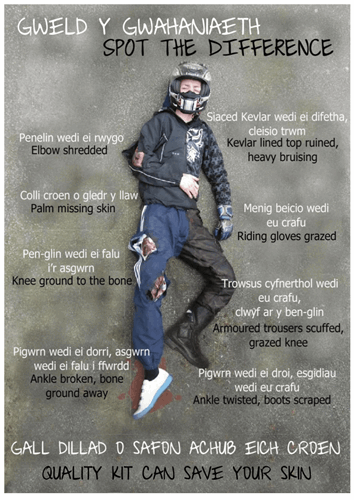What you wear is your only protection against injury if you're unfortunate to be involved in a collision while out on your motorcycle.
It’s so important to always be kitted out correctly with the right clothing and equipment, whatever bike you ride - even if you’re just popping to the shop.
Take a good look at your kit, is it in need of replacement? With Christmas around the corner it could be time to add a few items to your Christmas wish list?
Helmet
When riding on the road, you must wear a motorcycle helmet that fits properly and is correctly fastened. This will reduce the risk of receiving head or brain injuries if you’re involved in a collision. Remember, you may be a fantastic rider but you could still get caught up in a collision that wasn’t your fault.
Make sure your helmet complies with the relevant safety standards and never buy a second hand helmet as you won’t know the full history of it. A helmet that has been involved in an impact should always be replaced, even if there is no visible damage.
SHARP, the Helmet Safety Scheme
SHARP, the Helmet Safety Scheme provides an independent assessment of how much protection a helmet can offer in an impact, and rates helmets from 1 to 5 stars. The more SHARP stars a helmet has, the better the protection it can give. You can find more details on the SHARP website.
It's important that the helmet fits you snugly and does not move about on your head so it's well worth taking the time to find the right helmet.
Visor and Goggles
If you have an open-faced helmet, using a visor or goggles is vital to protect your eyes from wind, rain, insects and road dirt. Your visor and goggles must be kept clean, and if they become heavily scratched, they should be replaced.
Never wear tinted glasses, visors or goggles if riding in the dark or when there’s poor visibility.
Clothing
Jacket and Trousers
Good quality motorcycle clothing with a high safety rating will not only protect you from the wet and cold, it could make the difference between getting some bumps and bruises and sustaining injuries that could stop you riding again.
When choosing clothing look for abrasion resistant materials, such as leather, as well as padding or body armour to protect from impact injuries. Also look to see if the clothing is waterproof or if additional waterproof layers will need to be purchased. Fluorescent and reflective garments will also make you more visible to drivers.
If leather’s not your thing, it’s possible to get really good quality 'casual' motorcycle clothing made with a mix of heavy duty denim and Kevlar weave. Whatever you do, never ever go out wearing jeans and a t-shirt – if you come off your bike, the tarmac will shred through them in seconds.
Gloves
The first thing you do in a crash is put your hands out to protect yourself – it’s just instinctive. A decent pair of gloves is essential all year round. They’ll protect your hands from cold, wet weather and from injury if you do come off.
Boots
It is equally important to wear good boots or strong footwear which cover the ankle when riding. You may have spent £200 on your smart-looking trainers but they won’t protect your feet or ankles like a sturdy pair of boots will.
Wearing the right kit really does save lives. Hopefully you’ll never to need to rely on it, but quality kit could save your skin.
